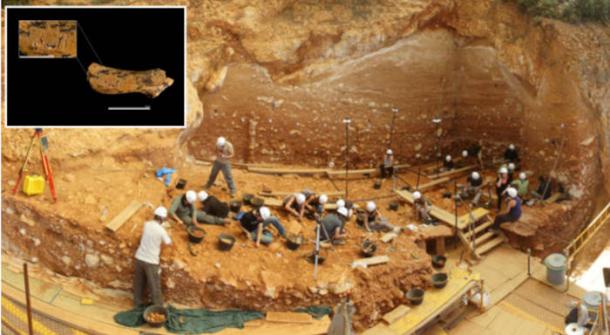Top Stories
Shocking Evidence of Cannibalism Found Among Early Humans

A recent discovery at the Gran Dolina site in Spain’s Atapuerca region has unveiled startling evidence of cannibalism among early European ancestors. Researchers unearthed an 850,000-year-old cervical vertebra belonging to a child aged between two and four years. The vertebra exhibits distinct cut marks that suggest deliberate decapitation, indicating that members of the species Homo antecessor practiced cannibalism as part of their dietary strategies.
The findings were shared by Dr. Palmira Saladié, a researcher with the IPHES-CERCA and co-coordinator of the Gran Dolina excavations. In a press release, she emphasized the significance of this discovery: “This case is particularly impactful: not only due to the child’s age, but also due to the precision of the cut marks. The vertebra shows clear incisions at key anatomical points for detaching the head. It’s direct evidence that this child was processed like any other prey.”
Insights into Early Human Behavior
The evidence from Atapuerca highlights a disturbing aspect of survival strategies among early humans. Cannibalism, often considered a taboo in modern societies, may have been a pragmatic response to environmental pressures during this period. Researchers believe that such practices could have been driven by a combination of nutritional needs and social behaviors.
The Gran Dolina site, known for its rich archaeological record, has previously yielded numerous remains that provide insights into the lives of early humans. The discovery of the child’s vertebra adds a new dimension to the understanding of social dynamics and survival tactics of Homo antecessor.
Excavations at the site have been ongoing for decades, revealing evidence of complex social interactions and subsistence strategies among early human populations. The latest find reinforces the idea that cannibalism was not merely a rare occurrence but possibly a regular aspect of life for these ancient communities.
Implications for Understanding Human Evolution
The implications of this discovery extend beyond the immediate findings. It challenges prevailing notions of early human behavior and raises questions about the social structures that existed at the time. The presence of cut marks on a child’s remains suggests a level of brutality that may reflect harsh survival conditions.
Researchers continue to analyze the context of this find, hoping to understand more about the dietary practices of Homo antecessor and how they adapted to their environment. The study of these remains not only sheds light on dietary habits but also provides a window into the psychological and social aspects of early human life.
As excavations at Atapuerca progress, more discoveries are anticipated, potentially further illuminating the complex lives of our ancient relatives. This latest evidence of cannibalism underscores the intricate and often grim realities faced by early humans as they navigated a world filled with challenges.
-

 Top Stories3 months ago
Top Stories3 months agoTributes Surge for 9-Year-Old Leon Briody After Cancer Battle
-

 Entertainment4 months ago
Entertainment4 months agoAimee Osbourne Joins Family for Emotional Tribute to Ozzy
-

 Politics4 months ago
Politics4 months agoDanny Healy-Rae Considers Complaint After Altercation with Garda
-

 Top Stories4 months ago
Top Stories4 months agoIreland Enjoys Summer Heat as Hurricane Erin Approaches Atlantic
-

 World5 months ago
World5 months agoHawaii Commemorates 80 Years Since Hiroshima Bombing with Ceremony
-

 Top Stories3 months ago
Top Stories3 months agoNewcastle West Woman Patricia Foley Found Safe After Urgent Search
-

 Top Stories5 months ago
Top Stories5 months agoFianna Fáil TDs Urgently Consider Maire Geoghegan-Quinn for Presidency
-

 World5 months ago
World5 months agoCouple Convicted of Murdering Two-Year-Old Grandson in Wales
-

 World5 months ago
World5 months agoGaza Aid Distribution Tragedy: 20 Killed Amid Ongoing Violence
-

 World5 months ago
World5 months agoAristocrat Constance Marten and Partner Convicted of Infant Murder
-

 Top Stories4 months ago
Top Stories4 months agoClimbing Errigal: A Must-Do Summer Adventure in Donegal
-

 Top Stories4 months ago
Top Stories4 months agoHike Donegal’s Errigal Mountain NOW for Unforgettable Summer Views









